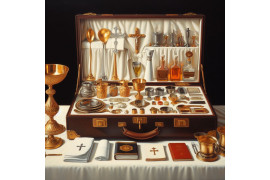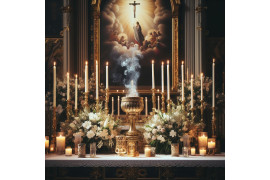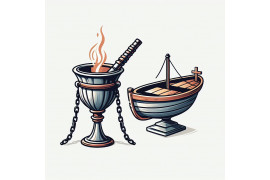The shape of a liturgical vessel, called a monstrance, resembling the radiant sun, holds deep symbolism within religious traditions. It is used to display the divine mystery of the holy communion and is often kept in the tabernacle. This divine vessel, known as the tabernacle or ciborium, often made of gilded metal or glass, serves as an image that represents the glory and radiance of God. It holds the holy communion for perpetual adoration. Its circular form signifies the divine mystery of the holy communion and the eternal presence of Christ in the blessed sacrament, contained within the liturgical vessel. The rays extending from the center of the sun god symbolize the divine light that shines upon believers in the tabernacle, illuminating their souls with spiritual enlightenment during perpetual adoration and private adoration.
In ancient times, the church was a place where the priest would perform rituals and ceremonies. One important element of the church was the tabernacle, which served as a sacred space for perpetual adoration. Sun worship, though significant in various cultures, did not have the same importance as the practices within the church. The resemblance between a monstrance, used for perpetual adoration of the blessed sacrament, and a sunburst reflects the historical connection to reverence for the sun god in the church. Today, during Mass or adoration ceremonies, when the consecrated host is placed within the tabernacle or monstrance, it becomes a treasured object that allows believers to contemplate and adore the presence of God in the blessed sacrament.
The tabernacle's resemblance to the sun invites us to ponder on its profound meaning as we seek spiritual nourishment and connection with the divine mystery in perpetual adoration of the blessed sacrament at church. Let us explore further how the tabernacle, blessed sacrament, and perpetual adoration serve as a bridge between heaven and earth, guiding our hearts towards greater faith and devotion to the sun god.
The Purpose of a Monstrance: Revealing the Eucharist to Believers
The use of monstrances in Catholic liturgy serves an important purpose - to display and honor the blessed sacrament in the tabernacle during Eucharistic adoration. The cardinal leads the faithful in this practice, typically for an hour. By placing the Blessed Sacrament within a monstrance, it becomes visible for worshipers to adore and contemplate during perpetual adoration.
The transparent glass or crystal in a monstrance allows believers to see and connect with Christ's real presence during perpetual adoration of the blessed sacrament. This unique design is often compared to the sun, symbolizing the radiance and glory of God shining through the Blessed Sacrament in perpetual adoration.
Monstrances: A Witness to Christ's Real Presence
When a priest consecrates the bread during Mass, it undergoes transubstantiation, transforming into the body of Christ, which is then placed in the blessed sacrament for perpetual adoration. This consecrated host, also known as the blessed sacrament, is then placed inside a tabernacle for safekeeping until it is used for communion or adoration. However, Monstrances play a crucial role.
Monstrances are designed with an opening in the center where the blessed sacrament, the consecrated host, is displayed. This opening allows believers to witness and venerate Christ's real presence in the sacrament of the Eucharist. It serves as a visual reminder that Jesus is truly present among his followers.
Exposition: An Act of Worship and Adoration
During Eucharistic adoration, the priest or deacon removes the consecrated host from the tabernacle and places it within the monstrance. This act of exposition brings forth an opportunity for believers to gather around and offer their prayers, praises, and adoration directly to Christ.
Expositions typically take place on special occasions such as Holy Thursday or during specific periods dedicated to adoration. The faithful come before the exposed Eucharist with reverence and devotion, recognizing that they are in the presence of their Lord.
Connecting with God's Divine Light
The comparison between a monstrance and the sun goes beyond just their physical resemblance. Just as the sun provides light and warmth to the world, the Eucharist within a monstrance is believed to radiate God's divine presence and grace.
When believers gather in front of a monstrance, they bask in the spiritual light emanating from the exposed Eucharist. This experience allows them to connect with God on a deeper level, seeking solace, guidance, and strength through their worship and adoration.
The Power of Contemplation
The use of a monstrance also encourages contemplation among believers. As they gaze upon the consecrated host within its radiant vessel, they are invited to reflect on Christ's sacrifice and love for humanity. It provides an opportunity for personal introspection, prayerful meditation, and a deepening of one's faith.
Addressing Misconceptions: Debunking the Paganism Myth
Contrary to misconceptions, the use of sun-like symbols in Christianity predates any pagan associations. The adoption of solar symbolism by early Christians was intended to convey spiritual concepts rather than pagan worship. Understanding the historical context helps dispel misunderstandings about Christian symbolism.
Solar Symbolism in Early Christianity
Many people mistakenly believe that the use of sun-like symbols, such as the monstrance, in Christianity is derived from pagan practices. However, this is not accurate. In fact, the adoption of solar symbolism by early Christians predates any association with paganism.
Early Christians used solar imagery to represent spiritual concepts and theological ideas. The sun was seen as a powerful symbol of divine light and glory, representing the presence of God. It was believed that just as the physical sun illuminates and sustains life on Earth, so too does God's grace illuminate and nourish believers' souls.
Spiritual Significance of the Monstrance
The monstrance, often adorned with rays resembling a sunburst or halo, serves a specific purpose in Catholic worship. It is used to display and honor the Eucharist—the consecrated bread believed to be transformed into the body of Christ during Mass.
The choice to incorporate sun-like elements into the design of a monstrance is rooted in its symbolic meaning. Just as sunlight brings warmth and life-giving energy to Earth, so too does Christ's presence in the Eucharist bring spiritual nourishment and salvation to believers.
Historical Context Matters
To fully understand why Christian symbols resemble those found in other cultures or religions, it is crucial to consider the historical context. Early Christianity emerged within a diverse cultural landscape influenced by various traditions and beliefs.
During this time period, religious symbols often transcended cultural boundaries and were repurposed for different spiritual contexts. This cross-pollination resulted in similarities between different belief systems' visual representations.
Dispelling Misunderstandings
It is important to dispel the myth that Christian symbolism, including sun-like imagery, is inherently pagan. While there may be similarities in artistic depictions, the underlying meanings and intentions behind these symbols differ significantly.
Understanding the historical development of Christian symbolism helps clarify its distinctiveness and purpose. By appreciating the spiritual significance attached to sun-like symbols in Christianity, we can debunk misconceptions and foster a more profound understanding of religious practices.
Origins and History of the Monstrance: A Brief Journey Through Time
The use of monstrances dates back to medieval times, serving as vessels for displaying consecrated hosts outside of Mass. Initially, they were simple containers used for transporting Communion elements during processions. However, over the centuries, these vessels evolved into elaborate works of art that reflected cultural influences and became an integral part of religious traditions.
During the Middle Ages, when Christianity was deeply rooted in society, people sought ways to display the Eucharist for public veneration. Monstrances played a crucial role in fulfilling this need. They allowed priests to showcase the consecrated host while parading through the streets during processions or when presenting it for adoration in churches.
As time went on, craftsmen began to enhance the design and aesthetic appeal of monstrances. These intricate creations showcased skilled metalwork and precious materials such as gold, silver, and jewels. The craftsmanship behind these pieces turned them into valuable treasures that are often displayed in museums today.
Monstrances from different regions exhibited distinct styles influenced by their respective cultures. For instance, Spanish monstrances often featured intricate filigree work and vibrant enamel detailing. On the other hand, German monstrances tended to be more ornate, with intricate carvings and delicate figurines adorning their surfaces.
The historical significance attached to monstrances makes them fascinating artifacts worth exploring further. They provide insights into religious practices during specific periods and shed light on the artistic achievements of various civilizations.
For example:
-
A monstrance from 14th-century France showcases Gothic influences with its pointed arches and delicate tracery.
-
A monstrance from Renaissance Italy features elaborate floral motifs inspired by classical art.
-
An intricately designed baroque-style monstrance from Spain displays opulent details like cherubs and swirling patterns.
These historical examples demonstrate how each period left its unique mark on the design and symbolism associated with monstrances.
Today, monstrances continue to be used in religious ceremonies and processions, preserving the traditions that have been passed down through generations. They serve as a powerful symbol of the sun, representing the radiant presence of Christ. The intricate craftsmanship and historical significance associated with these vessels make them objects of reverence and admiration.
Symbolism of the Sun: Explaining the Connection to Monstrances
The sun has always held a special place in human culture and spirituality. Across various civilizations and belief systems, it has been associated with divinity, enlightenment, and life-giving power. In Christianity, the symbolism of the sun is deeply intertwined with the concept of Christ as "the Light" or "the Sun," highlighting his role as an illuminator and a source of life.
Incorporating sun symbolism into monstrances serves to emphasize Christ's presence and his transformative power in the Eucharist. Let's delve into this connection further:
The Divine Light
Throughout history, people have recognized the sun as a symbol of divine light. Just as sunlight illuminates and brings warmth to our world, Jesus is seen as the spiritual light that guides humanity towards truth and salvation. Monstrances, with their radiant designs often featuring rays emanating from a central host holder, capture this symbolism by visually representing Christ's divine radiance.
The Source of Life
The sun is also closely associated with life-giving power. Its energy sustains all living beings on Earth, providing nourishment and enabling growth. In Christianity, Jesus is believed to be the ultimate source of spiritual life through his sacrifice on the cross and resurrection. By incorporating elements reminiscent of the sun into monstrances, such as golden hues or intricate designs resembling solar motifs, this connection between Christ's life-giving power and the sun is emphasized.
Transformation and Renewal
Another aspect tied to both the sun and monstrances is transformation. The rising sun each morning signifies a new day—a fresh start filled with potential for growth and renewal. Similarly, during Mass when consecrated hosts are placed within monstrances for adoration or processions, there is a profound belief in their transformation into the body of Christ. This act symbolizes not only a physical change but also a spiritual metamorphosis, where believers are invited to encounter Christ's presence and experience personal transformation.
Reflecting God's Glory
The sun's brilliance and radiance have often been used as metaphors for reflecting God's glory. Just as the moon reflects the light of the sun, Christians are called to reflect the divine light of Christ in their lives. Monstrances, with their ornate designs and reflective surfaces, serve as a visual representation of this call to reflect God's glory. They remind believers that they are vessels through which Christ's light can shine forth into the world.
Diverse Designs: Variations in Monstrance Shapes and Styles
Monstrances, as liturgical vessels used for displaying the consecrated Eucharist during adoration or benediction, come in a wide array of shapes and styles. Let's explore the diverse designs that these sacred objects can take on.
Various Shapes: Circular, Oval, and Architectural Designs
One notable aspect of monstrances is their varied shapes. While some are circular or oval in form, resembling a radiant sunburst, others adopt more elaborate architectural designs. These different shapes serve both practical and symbolic purposes within the context of religious worship.
Circular and oval-shaped monstrances are commonly seen in churches and chapels around the world. Their symmetrical design allows for easy display of the consecrated host while providing an aesthetically pleasing focal point for worshipers. The circular shape symbolizes unity, eternity, and perfection—attributes closely associated with the divine presence.
On the other hand, architectural-style monstrances often feature intricate details reminiscent of grand cathedrals or historical structures. These designs may reflect regional artistic traditions or specific historical periods. For example, during the Counter-Reformation period in Europe (16th-17th centuries), monstrances were crafted with ornate embellishments to counteract Protestant iconoclasm and emphasize the importance of visual representation in Catholic worship.
Elaborate Embellishments: Precious Metals, Gemstones, Filigree Work
Elaborate embellishments are common features found on many monstrances. Craftsmen employ various techniques to enhance their beauty and significance as sacred objects.
Precious metals such as gold or silver are often used to construct the framework of a monstrance. These metals lend durability and symbolize purity and richness, befitting their purpose. Gemstones like diamonds or rubies may be incorporated into the design to add splendor and magnify the radiance of the Eucharist.
Intricate filigree work is another hallmark of many monstrances. This delicate technique involves meticulously shaping and intertwining thin metal wires to create intricate patterns and designs. Filigree adds an element of elegance and craftsmanship, elevating the overall aesthetic appeal of the monstrance.
Regional Styles and Historical Significance
Monstrances can vary in style based on regional influences and historical contexts. Different countries or religious orders may have their distinct design preferences, reflecting their cultural heritage and artistic traditions.
For example, Spanish-style monstrances often feature ornate baroque designs with elaborate scrollwork, while German monstrances may showcase Gothic-inspired elements such as pointed arches or spires. These regional styles highlight the diversity within Catholic worship and provide insights into the historical development of religious art and architecture.
Monstrances and Eucharistic Adoration: Enhancing Devotion and Worship
Eucharistic adoration is a practice that allows believers to express their reverence and devotion towards the consecrated host, also known as the Holy Eucharist. During this time of private adoration, worshipers have the opportunity to deepen their spiritual connection with Christ through prayer and contemplation. One of the key elements in Eucharistic adoration is the use of a monstrance.
Focusing Attention on Christ's Real Presence
A monstrance is a sacred vessel used to display and honor the consecrated host. It typically consists of a sunburst-like design, often adorned with precious metals and gemstones. The radiant appearance of the monstrance serves as a visual representation of Christ's real presence in the Eucharist. Just as the sun radiates light and warmth, so too does Christ's presence illuminate our lives with grace and love.
By gazing upon the exposed Eucharist within the monstrance, worshipers are drawn into a more profound awareness of Christ's real presence among them. The brilliance of the monstrance reflects both the majesty and mystery of God's divine presence. This visual focus helps to center one's attention solely on Christ during moments of adoration, allowing for a more profound experience of communion with Him.
Deepening Spiritual Connection with Christ
The act of adoring the Eucharist in a monstrance goes beyond mere observation; it invites believers to actively engage in conversation with Jesus through prayer and meditation. As worshipers fix their gaze upon the exposed host, they are reminded that they are in direct communion with Jesus Himself.
During these holy hours spent before the Blessed Sacrament, individuals can pour out their hearts to Jesus, offering Thanksgiving, seeking guidance, or simply resting in His loving presence. The quiet stillness within an adoration chapel creates an atmosphere conducive to listening attentively to the voice of God and receiving His grace.
Strengthening Faith and Devotion
Eucharistic adoration, with the use of a monstrance, serves as a powerful means to deepen one's faith and devotion. The physical presence of the Eucharist in the monstrance reinforces the belief in Christ's true presence in the consecrated host. This tangible reminder strengthens believers' trust in the teachings of the Church regarding the Holy Eucharist.
Moreover, regular participation in Eucharistic adoration can lead to a greater desire for frequent reception of Holy Communion during Mass. As worshipers spend time before the exposed Eucharist, their love for Christ grows, fueling their longing to receive Him sacra mentally. This deepened devotion often inspires individuals to attend Mass more frequently and participate fully in the liturgy.
Reflecting on the Profound Significance of Monstrances
We have discovered that the primary purpose of a monstrance is to reveal the Eucharist to believers, allowing them to engage in deep devotion and worship. By addressing misconceptions surrounding pagan influences, we debunked the myth that monstrances are rooted in paganism.
Furthermore, we delved into the origins and history of monstrances, taking a brief journey through time to understand their evolution. We explored the symbolism of the sun and its connection to monstrances, revealing how it represents Christ's divine presence and radiance. We discussed the diverse designs of monstrances, showcasing variations in shapes and styles across different cultures.
By understanding these aspects, we gain a deeper appreciation for why monstrances are like a sun – they illuminate our faith and guide us towards spiritual enlightenment. Whether you are a devout believer or someone seeking knowledge about religious artifacts, exploring more about monstrances will enhance your understanding of Eucharistic adoration.
FAQs
What is Eucharistic adoration?
Eucharistic adoration is a practice within Catholicism where individuals spend time in prayer before the consecrated host (the Eucharist) exposed in a monstrance. It allows believers to express their devotion and reverence for Jesus Christ present in the Eucharist.
Are all monstrances shaped like suns?
No, not all monstrances are shaped like suns. While some do feature rays reminiscent of sunlight emanating from a central host display area, others may have different designs depending on cultural influences or artistic preferences.
Can anyone participate in Eucharistic adoration?
Yes! Eucharistic adoration is open to all individuals who wish to deepen their faith or seek solace through prayer. You can participate by visiting churches or chapels that offer Eucharistic adoration and spend time in silent contemplation or recitation of prayers.
Are monstrances used in other Christian denominations?
Monstrances are primarily associated with Catholicism. However, some Anglican and Lutheran churches also incorporate the use of monstrances during special services or occasions.
Can I purchase a monstrance for personal use?
Yes, you can purchase a monstrance for personal use. However, it is essential to consult your local church authority or clergy to ensure that you understand the significance and proper usage of a monstrance within your religious tradition.



